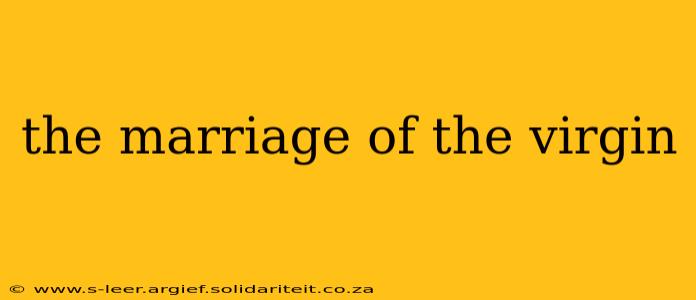The Marriage of the Virgin: Exploring the Diverse Interpretations of a Powerful Symbol
The "marriage of the virgin" is a potent symbol found across numerous religious and mythological traditions, often signifying a profound spiritual union, renewal, or a powerful connection between the divine and the earthly. However, the specific interpretations vary significantly depending on the cultural and religious context. This exploration will delve into the diverse meanings associated with this archetype, addressing common questions and misconceptions.
What does the "marriage of the virgin" symbolize?
The symbolic meaning of the "marriage of the virgin" isn't singular; it's multifaceted and rich with nuanced interpretations. In many traditions, it represents the union of the divine feminine and masculine principles, signifying creation, fertility, and spiritual enlightenment. The virgin, often representing purity, innocence, or untapped potential, undergoes a transformative union, resulting in a new birth, a spiritual awakening, or the manifestation of divine power. This "marriage" isn't necessarily a physical union, but rather a symbolic one representing the integration of opposing forces or the culmination of a spiritual journey.
What are some examples of the "marriage of the virgin" in different cultures and religions?
The motif of the "marriage of the virgin" appears in various forms throughout history. In some interpretations of Christianity, the marriage of the Virgin Mary to the Holy Spirit symbolizes the immaculate conception of Jesus. Other interpretations focus on the mystical union of the soul with God, where the "virgin" represents the unblemished spirit seeking divine connection. In pagan traditions, similar themes emerge, with goddesses often depicted in symbolic marriages representing the cyclical nature of life, death, and rebirth, or the union of earthly and celestial realms. For instance, the union of Demeter and Persephone in Greek mythology reflects the changing seasons and the cyclical nature of life. The variations are extensive, highlighting the universality of this powerful archetype.
Is the "marriage of the virgin" always about a literal marriage?
No, absolutely not. The "marriage" in this context is almost always symbolic rather than literal. It represents a sacred union, a transformative experience, or a powerful spiritual connection. The emphasis is on the joining of seemingly disparate forces, resulting in a new creation, a spiritual awakening, or a manifestation of divine power. The "virgin" aspect highlights the purity, potential, or untainted nature of the entity undergoing this transformation. The emphasis is on the spiritual journey and its transformative effect, not a physical act.
How is the "marriage of the virgin" depicted in art and literature?
The "marriage of the virgin" has inspired countless artistic and literary interpretations throughout history. Depictions vary widely depending on the cultural and religious context. In Christian art, the marriage of the Virgin Mary is often represented through symbolic imagery, emphasizing her purity and the divine nature of the conception. In pagan art, similar themes are explored, often highlighting the fertility and regenerative power of the goddess. Literary interpretations delve into the spiritual and psychological aspects of this archetypal theme, exploring themes of transformation, self-discovery, and the quest for spiritual enlightenment. The wide array of artistic and literary portrayals underscores the enduring power and adaptability of this symbolic motif.
What is the significance of the "virgin" aspect of the "marriage of the virgin"?
The "virgin" aspect in this symbolic marriage emphasizes several key concepts. It often represents purity, innocence, or untainted potential. It signifies something whole, unblemished, or ready for a transformative experience. The "virgin" isn't necessarily tied to sexual innocence; instead, it signifies a state of readiness or preparedness for a significant spiritual or transformative union. The emphasis is on the potentiality and the subsequent transformation that occurs through the union.
The "marriage of the virgin" remains a potent and multifaceted symbol, its meaning shaped and reshaped by diverse cultural and religious perspectives. Its enduring presence in art, literature, and religious traditions underscores its significance as a powerful archetype reflecting humanity's enduring fascination with the mysteries of creation, transformation, and spiritual awakening.
